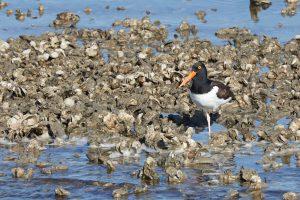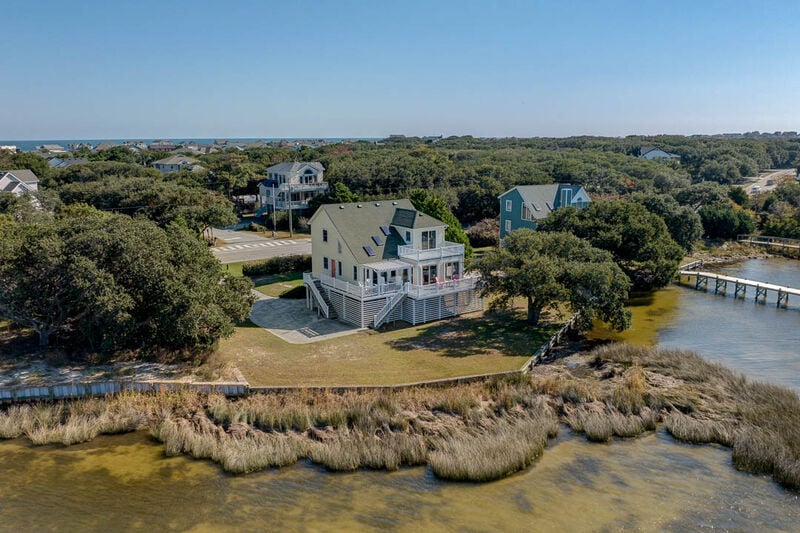
If you're dreaming of a different kind of vacation, or a more active vacation, an ecotourism trip to the Outer Banks may be just what you're looking for. Ecotourism is defined by the World Conservation Union as "environmentally responsible travel to natural areas in order to enjoy and appreciate nature and accompanying cultural features that promote conservation, have low visitor impact, and provide for beneficially active socio-economic involvement of local people."In other words, ecotourism is about having a deeper experience wherever you're traveling while having less impact on the environment.
Ecotourism Opportunity: Oyster Reef Restoration
The Outer Banks have a special ecotourism opportunity: Oyster Reef Restoration. Oysters are a delicious staple of coastal cuisine, but they also perform a very important environmental function: Clustered oysters can be home to up to 300 species of plants and animals, and just one oyster can filter about 50 gallons of water per day. Oyster beds also protect coastal areas from erosion by buffering ocean waves and storm surge.
Oysters: Popular to the Point of Extinction
Oysters were once an important trade commodity in North Carolina — they were easy for colonists to exchange for much-needed supplies. After the Civil War, people all over the country developed a taste for oysters and vast oyster houses and canneries sprang up all along the East Coast. To keep up with market demand, oyster fishermen nearly decimated oyster beds in the late 19th century. In the 20th century, building along the coast, agricultural chemicals, and timbering also threatened oysters. In the late '80s, a disease specific to oysters was nearly the final blow for everyone's favorite bivalve.
Restoring Oyster Sanctuaries
Oysters grow in estuaries, or unique areas where fresh water mixes with ocean water. Estuaries are protected from the full force of the ocean, so they are a safe place for fish and birds to grow up. In fact, estuaries are among the most critical habitats in the world, and oysters love them.Currently, 85% of oyster reefs have been lost, making oyster reefs the most severely impacted marine habitat on the planet. Pamlico Sound in the Outer Banks was once home to an extensive oyster reef habitat. However, more than 50% of the original habitat was lost to overharvesting, poor water quality, and disease.In 2002 the Nature Conservancy began testing ways to restore oyster reefs around Pamlico Sound, resulting in more than 65 acres of new habitat.Improved oyster habitats have yielded a regrowth of these hardworking mollusks, reduced erosion, improved water quality, and improved habitat for fish and plants that depend on oyster beds.Another benefit is a slight rise in populations of the American Oystercatcher bird. The oystercatcher is a black-and-white bird with a bright red bill. Flocks of oystercatchers are a beautiful sight along the coasts, where they feed on clams, oysters, and mussels. Other environmental issues such as sea level rise and a loss of territory threaten oystercatchers, but an increase in clean oyster beds increases their chances of survival.
How Oyster Beds Are Seeded
Free-swimming oyster larvae need a hard surface where they can attach and grow together, and recycled oyster shells make the perfect nursery. If you've been to an oyster roast recently, you may notice that discarded shells are collected in large barrels and separated from trash. Oyster shells are handed over to conservation groups, who clean and bag them, then place them in oyster "sanctuaries" to attract new oysters.Restoring oyster reefs is a community effort. First, fishermen take oysters only from state-regulated oyster beds with populations healthy enough for harvesting. Local residents and restaurants save and recycle oyster shells, then volunteers and environmental groups clean, bag, and store shells until it's time to plant them in the summer.Planting oyster shells means taking bags of shells to oyster sanctuaries in shallow water and spreading them along the bottom in sections about 12 feet apart. Some volunteers are also needed to monitor the sanctuaries and check water quality.
Nags Head Woods Oyster Reef Restoration
In the summer Nags Head Woods offers periodic work days to help with oyster reef restoration in the Outer Banks. Volunteers will collect shells, bag oysters, build oyster mats and oyster reefs, and plant the marshes with shells. Volunteering for oyster reef restoration is a great project for families because there are jobs for all ages. Getting kids involved in ecotourism is also a wonderful way to encourage thoughtful travel practices while having a fun local experience few others have.Oysters are an important staple in coastal cuisine, but they're also an important part of the marine ecosystem. Ecotourism opportunities such as those that allow visitors to help restore oyster sanctuaries offer a unique way to see the Outer Banks from a different vantage point, to learn, and to tread lightly as you travel.
 If you're dreaming of a different kind of vacation, or a more active vacation, an ecotourism trip to the Outer Banks may be just what you're looking for. Ecotourism is defined by the World Conservation Union as "environmentally responsible travel to natural areas in order to enjoy and appreciate nature and accompanying cultural features that promote conservation, have low visitor impact, and provide for beneficially active socio-economic involvement of local people."In other words, ecotourism is about having a deeper experience wherever you're traveling while having less impact on the environment.
If you're dreaming of a different kind of vacation, or a more active vacation, an ecotourism trip to the Outer Banks may be just what you're looking for. Ecotourism is defined by the World Conservation Union as "environmentally responsible travel to natural areas in order to enjoy and appreciate nature and accompanying cultural features that promote conservation, have low visitor impact, and provide for beneficially active socio-economic involvement of local people."In other words, ecotourism is about having a deeper experience wherever you're traveling while having less impact on the environment. If you're dreaming of a different kind of vacation, or a more active vacation, an ecotourism trip to the Outer Banks may be just what you're looking for. Ecotourism is defined by the World Conservation Union as "environmentally responsible travel to natural areas in order to enjoy and appreciate nature and accompanying cultural features that promote conservation, have low visitor impact, and provide for beneficially active socio-economic involvement of local people."In other words, ecotourism is about having a deeper experience wherever you're traveling while having less impact on the environment.
If you're dreaming of a different kind of vacation, or a more active vacation, an ecotourism trip to the Outer Banks may be just what you're looking for. Ecotourism is defined by the World Conservation Union as "environmentally responsible travel to natural areas in order to enjoy and appreciate nature and accompanying cultural features that promote conservation, have low visitor impact, and provide for beneficially active socio-economic involvement of local people."In other words, ecotourism is about having a deeper experience wherever you're traveling while having less impact on the environment.







